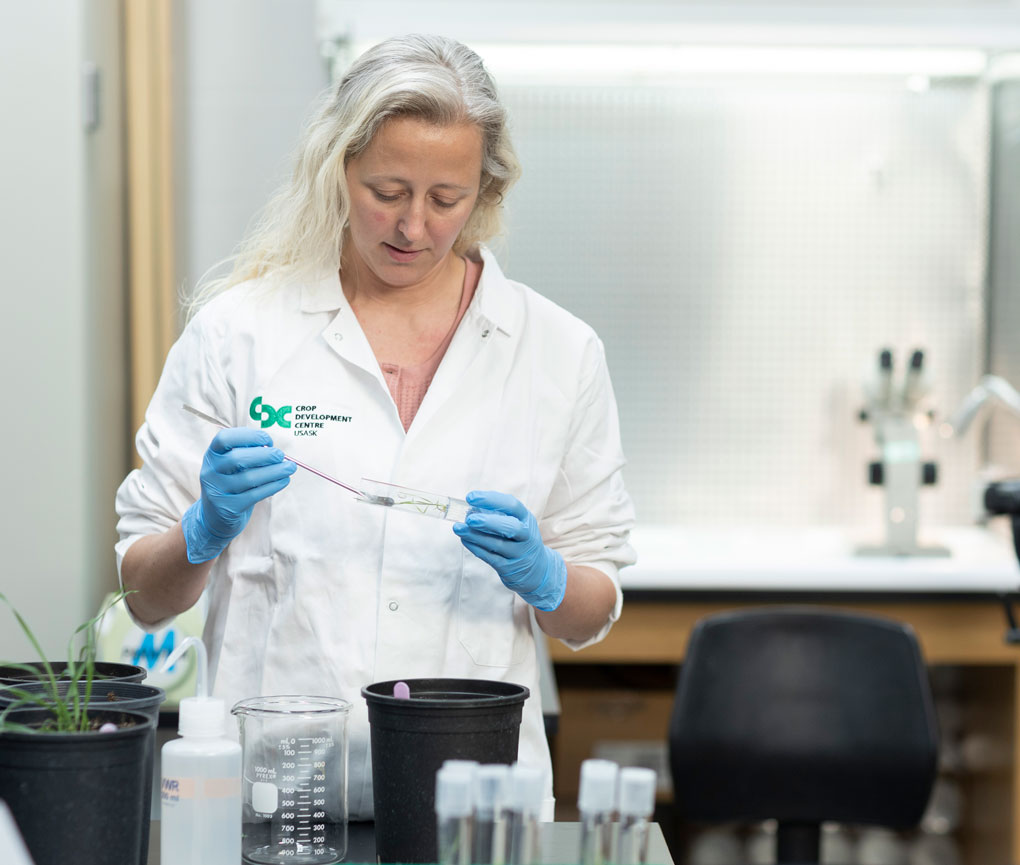Saskatoon, Saskatchewan, Canada
Jul 11, 2023
 Krystalee Wiebe works in the durum wheat molecular genetics laboratory in the agriculture building at USask (photo: Dave Stobbe)
Krystalee Wiebe works in the durum wheat molecular genetics laboratory in the agriculture building at USask (photo: Dave Stobbe)
Krystalee Wiebe is optimistic that USask genetic research projects in wheat and durum will be vital in addressing future agricultural challenges.
Krystalee Wiebe, a research officer with the University of Saskatchewan (USask) Crop Development Centre (CDC), describes her work as translational. As a research officer, Wiebe specializes in durum (“pasta wheat”), and she is integral in projects that generate data from the ground up. Research teams at USask collaborate to decode and generate genetic sequences of different wheat (varieties/types/crops) with the aim of making durum better for producers. Wiebe’s role is one of applying the CDC’s cutting edge research directly to breeding projects.
During her 17 years at the CDC, Wiebe has played a part in her fair share of world-altering research breakthroughs at the CDC. “It’s an exciting time to be in wheat research,” she says. “When I started my career, there were virtually no wheat genomic resources or DNA sequences available for wheat. All we had were little pieces of genetic information, but we lacked the whole picture. In the last 17 years, we have moved from having only a single genome sequence to having over 10 fully sequenced wheat varieties.” What Wiebe is referring to is the CDC’s leadership role in a world collaboration known as the “10 Wheat Genome Project” which began in 2011. The project’s explicit purpose is developing the wheat “pan genome”, which, simply put, is characterizing all genes and genetic variations within the wheat species, a goal to which huge advancements have been made over the last decade. That work continues at the CDC.
And it’s not just these research breakthroughs that make Wiebe’s application of research at USask so exciting: it’s the rapidly improving technology available to her and other researchers. One particularly exciting tool that is supporting her research is the 2020 Nobel Prize winning technology known as CRISPR-Cas9. Cas9 is a naturally-occuring enzyme that, in essence, acts as a pair of ‘molecular scissors’ which ‘cuts’ DNA at targeted locations so that pieces of genetic material can be added or removed. The applications of this technology are broad and open the door to truly innovative genetic research. Wiebe’s work is focusing on application of this technology to understand how individual genes function in wheat. Her work is a stepping stone to eventually deploying it as a tool in plant breeding.
On the more practical end of the spectrum, a number of projects Wiebe has been involved in during her time at the CDC have real-time implications for Canadian agriculture. Her Master of Science research project, as an example, focused on identifying the genetic material that was responsible for cadmium uptake. Cadmium is a heavy metal and undesirable in durum products. In fact, wheat products that exceed a certain threshold for cadmium content are not suitable for export. Other projects she has been involved in at the CDC look at genetic markers for genes of interest in wheat varieties that impact meaningful characteristics such as pest resistance, protein content, and colour. Some of this research involves rejuvenating the genetic diversity of wheat through the exploration of wild wheat genomes and introducing some of its desirable traits into modern domesticated cultivars.
When asked how her contributions will impact agriculture in the future, Wiebe says, “It’s really all about gathering genetic resources. Our international collaborations and the willingness of the CDC to be flexible in what kind of projects we engage in, all amount to a body of knowledge we can draw from as we face new challenges. We never know what issues will get thrown our way in agriculture, but this bank of resources can only help going forward.”